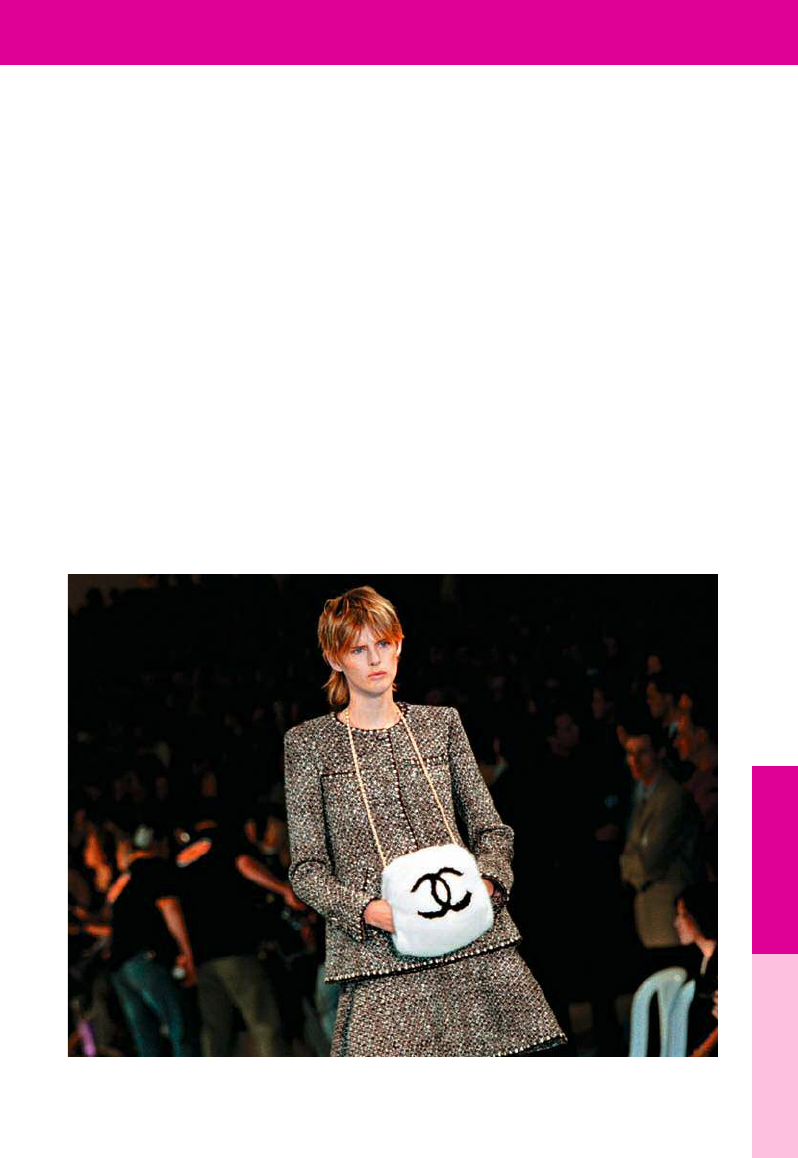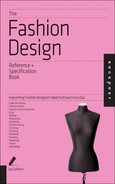
Job:02-30034 Title:RP-Fashion Design Ref and Spec Book
#175 Dtp:225 Page:198
198-203_30034.indd 198 2/27/13 5:10 PM
19 8 THE FASHION DESIGN REFERENCE + SPECIFICATION BOOK
(Text)
Chapter 19: Branding
The most common mistake regarding brands is to think that the company
name and logo are the brand. They are not. The brand is what the designer
or company stands for. Designers that consistently follow through on every
endeavor with integrity are building a brand: Anything associated with their de-
sign work should ring true, aligning with what the brand has pledged to deliver.
Another misconception about brands is that they belong to the designer or
company. They do not. The whole idea behind a good brand is that it connects
with people, and the moment a customer is let down in any way the brand has
suffered a blow. Brands are emotional things in which both the creators and
consumers have made an investment. They begin to have signi cance beyond
the actual products. Over time, a brand builds a philosophy and a way of doing
business; for the customer, the brand becomes a cultural accessory and a
source of inspiration.
A note on the term “luxury brand”: Because the idea of luxury has become
such a cliché, designers must determine what it means within the context of
their own brand. Does it imply a company that produces goods and services to
which many consumers would aspire, but because of rarity and restrictive price
point are not readily attainable? Or does it mean a company that has used
luxurious materials and invested in glamorous advertising and slick packaging,
but in essence supplies a basic, albeit desirable, commodity?
BRAND CONSTANTS
Mythology
When a designer has committed to the brand promise, the job at hand is to build a mythology
and craft the symbols that make it easy to identify and identify with. The myth is in the mes-
sage. A myth cuts past rational thought and connects with individuals at a gut level, where
they imagine themselves in what they have observed. Chanel is a brand based on the history
and vision of Gabrielle Chanel, an embodiment of the thoroughly modern woman. With time,
that history has become lore and then legend. The continued success of Chanel is due to in-
novative of-the-moment interpretations of all the things that she stood for as a designer and
as a woman. The Chanel customer knows what she is getting and identifies with the brand
because it means something more than just beautiful clothing. Like Chanel, a great design
house will always deliver on their promise and manage expectations.
W
A
M
M
n
i
m
it
b
m
T
A
a
is
lo
w
s
i
n
Ch
Photograph by Petit/Hel/Prestige/Newsmakers.
19
Job:02-30034 Title:RP-Fashion Design Ref and Spec Book
#175 Dtp:225 Page:198
198-203_30034.indd 198 2/27/13 5:11 PM

Job:02-30034 Title:RP-Fashion Design Ref and Spec Book
#175 Dtp:225 Page:199
Book
e:198
198-203_30034.indd 199 2/27/13 5:10 PM
19 9
(Text)
y
What’s in a Name?
A designer’s name and variations on it often become the brand name and its offshoots. Coco,
Mademoiselle Chanel’s nickname, is an extension of the Chanel brand. Similarly, Miu Miu,
Miucia Prada’s nickname, is an extension of the Prada brand. Developing an original company
name involves many considerations. Designers must determine its relevancy and the kind of
impact it might have. They must also look at whether the actual structure of the name lends
itself favorably to a variety of graphic interpretations: lowercase or capitals, cursive script or
block letters, serif or sans serif, color or black and white. Names that imply more than one
message or sound like something else are not likely to be memorable or unique.
The Logo
A logo translates a brand name and its message into a graphic representation. It becomes
a visual trigger, transcending language to convey everything that the designer has decided
is most important. Chanel’s design of interlocking Cs is easily one of the most recognizable
logos in fashion. It is used in all the traditional ways, but its simplicity also allows it to be
worked into the actual design of the products as closures, jewelry, and prints. Designers
should be aware that the contemporary fashion consumer is not apt to wear blatant advertis-
ing unless it is a rarity, cleverly incorporated into the design, or obviously meant to be ironic.
Chanel Fall/Winter 2001/2002 Collection
Photograph by Petit/Hel/Prestige/Newsmakers.
19
Job:02-30034 Title:RP-Fashion Design Ref and Spec Book
#175 Dtp:225 Page:199
Book
e:198
198-203_30034.indd 199 2/27/13 5:11 PM

Job:02-30034 Title:RP-Fashion Design Ref and Spec Book
#175 Dtp:225 Page:200
198-203_30034.indd 200 2/27/13 5:10 PM
2 0 0 THE FASHION DESIGN REFERENCE + SPECIFICATION BOOK
(Text)
BRAND DEVELOPMENT
Design Scheme
The message, name, and logo are the constants that will inform a brand’s overall design
scheme. The checklist of concerns that designers need to address includes color, pattern,
texture, font, quality of line, scale, flow, direction, and negative space. Designers must also
consider whether there will be one unchanging formula, or whether the design scheme might
be periodically reconfigured and recolored. They must ask how the design reads on a business
card and on a billboard, even how it looks when reproduced in black and white by an ordinary
photocopy or fax machine.
Packaging
The successful packaging of a designer’s product should bear a cohesive relationship to the
brand. Designers need to decide how the packaging will incorporate the name and logo and
how the various packaging elements will interact with each other. Whether color is to be used
to stimulate or as a neutral canvas for the product is another consideration. If a designer’s
packaging does no more than stamp every item with a logo, the overall impact will be clumsy
and heavy handed. By contrast, if the designer’s shopping bag is printed with a large version
of the logo that wraps around the bag, and the gift box inside is sealed with a ribbon and a
sticker bearing the embossed logo, then perhaps the tissue paper is printed with a pattern of
the full designer name. This example illustrates how the brand can be reinforced using many
different methods within a single delivery system.
Lexicon
The language in which a brand message is crafted must be chosen as carefully as any other
aspect. All copy should be populated with words pulled from a specific brand lexicon, a vo-
cabulary that will speak in the particular timber and tone the designer wishes to project. For
example, is a vibrant pink dress referred to as flirty and playful? Majestic and jewel toned?
Or shocking and provocative? Each description could apply to the same dress, but design-
ers must judge which combination of words is most closely aligned with their relationship to
the customer. Tag lines are the most economical use of language to deliver the essence and
promise of a brand. The phrase “Just do it” is as important a part of the Nike brand as the
company name or the swoosh logo.
B
D
at
T
d
b
th
w
T
In
D
se
o
th
p
d
f
o
m
T
A
S
b
g
ev
at
th
ru
a
19
Job:02-30034 Title:RP-Fashion Design Ref and Spec Book
#175 Dtp:225 Page:200
198-203_30034.indd 200 2/27/13 5:11 PM

Job:02-30034 Title:RP-Fashion Design Ref and Spec Book
#175 Dtp:225 Page:201
Book
e:200
198-203_30034.indd 201 2/27/13 5:10 PM
Branding 2 01
(Text)
s
Brand Profile
Designers who have diligently developed a business plan will have everything they need to cre-
ate a brand profile. This differs from the company’s profile, which concerns facts and figures.
The brand profile articulates the essence of the company. By crafting the profile themselves,
designers can steer the brand into the areas where it will be perceived in the light they wish to
be seen in. They also diminish the chance of being improperly branded by external forces and
thus being left at the helm of a brand that, no matter how successful, may not be what they
want to pursue.
The Book
In a small operation, the designer and a handful of individuals can easily keep on message.
Designers who can conceive of a time when not every decision will come across their desk will
see the value of developing a book to serve as a reference guide for the operations and devel-
opment of the company. This book is more than an employee handbook. It is a compendium of
the company’s history, implementations of the mission, collections produced, and press clip-
pings that provides the primary source of direction for developing standards, policies, proce-
dural guides, and staff manuals. The “book” can take many different forms: as a set of files,
folders, disks, or binders. Designers should make a habit of automatically copying relevant
materials and filing them away under the correct designation.
Thirty Seconds
Anyone associated with a designer brand should have a thirty-second pitch at the ready.
Sometimes called the elevator speech, this brief snapshot of a company speaks to the
brand’s mission, its audience, and its future. The more concise, informative, and targeted, the
greater the chances of breaking through the clutter of information everyone is inundated with
every moment of every day. The sound bite rules television, because airtime is expensive and
attention spans are short. Those who are most at ease on camera have prepared to deliver
their ideas in condensed form. An individual who has not tends to trail off and is soon inter-
rupted in this fast-paced forum. As helpful as these nuggets of information may be, however,
anyone who speaks for the brand still needs to be able to think on their feet.
19
Job:02-30034 Title:RP-Fashion Design Ref and Spec Book
#175 Dtp:225 Page:201
Book
e:200
198-203_30034.indd 201 2/27/13 5:11 PM

Job:02-30034 Title:RP-Fashion Design Ref and Spec Book
#175 Dtp:225 Page:202
198-203_30034.indd 202 2/27/13 5:10 PM
2 0 2 THE FASHION DESIGN REFERENCE + SPECIFICATION BOOK
(Text)
Advertising Extension
Under certain conditions, advertising offers a powerful tool to the fashion designer. First, the
content of the ad or commercial must reflect the spirit of the brand. Second, the designer
needs to be clear on the purpose of the advertising. Is it about generating sales? Attempting
to align the brand with industry leaders or peers? Part of a philanthropic campaign? Or simply
a vanity piece? The intent dictates the correct placement. A full-page, four-color glossy ad in
a high-profile national fashion magazine may be impressive, but does not guarantee a single
sale for a designer with a limited regional presence. The most important condition for making
an investment in advertising is that it be built on something real. When advertising is the natu-
ral extension of a brand history and reputation, the return is greater. Design integrity, the right
vehicle, and timing add up to results.
Advocates
Assuming that the highest standards of design, quality, and fit have been met and the loyalty
of clients secured, consumers can easily be prompted to sing a designer’s praises. But only
if the designer has provided the tools for them to do so. Designers can engage their clientele,
sharing ideas and experiences, through online communications, in-store promotions, and
special events. Even their approach to how much designers share about themselves with the
press and public will have an impact: Their personal lives might be an open book and a re-
flection of the brand, or it might be their mystery that captures their customers’ imagination.
Faithful clients become strong advocates of the brand because they are storytellers, spread-
ing the word.
Additionally, designers might employ a spokesperson who adds to the brand value. This could
be someone who is hired to endorse the product or someone already identified as a patron.
Designers might also target those who have no practical use for their product, but appreci-
ate the brand for other reasons and count themselves among its most vocal evangelists. For
instance, men don’t have a personal use for Victoria’s Secret lingerie (as a rule) but are a
primary focus of the company’s public presence via catalogues, advertising, and online or tele-
vised fashion shows.
C
B
b
ti
r
e
A
fi
b
te
ge
a
s
M
In
th
b
e
v
th
ch
s
w
19
Job:02-30034 Title:RP-Fashion Design Ref and Spec Book
#175 Dtp:225 Page:202
198-203_30034.indd 202 2/27/13 5:11 PM
..................Content has been hidden....................
You can't read the all page of ebook, please click here login for view all page.
